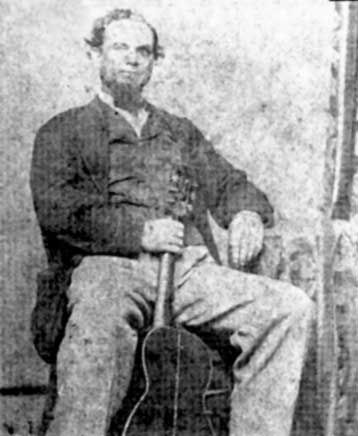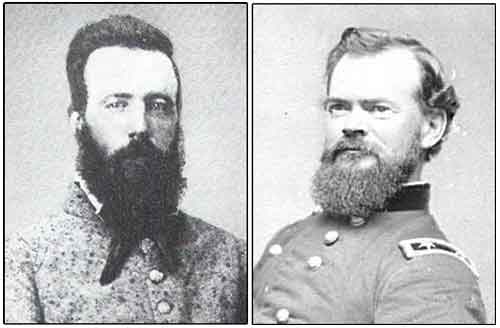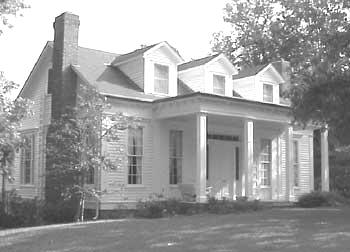"Raymond Years Ago"
By George W. Harper
Journalist - Editor - Owner Of Hinds County Gazette 1845-1883
A Series Published in the Hinds County Gazette, 1878-1879
From the Gillespie Collections edited by Pattie Adams Snowball and Rebecca Blackwell Drake
Home Page
Harper Arrives in Mississippi
Vicksburg & Meridian RR
Businesses in 1844
The Raymond Bar
Early Merchants
1844 Businesses
Seat of Justice
Cotton Industry
Early Churches
Establishment of Schools
John B. Peyton
Raymond Area Homes
Medicinal Resorts & Spas
The Mexican War
Early Churches
Early Schools
Raymond Female Institute
Raymond Military Institute
McNutt-Foote Debate
1844 Presidential Election
Local Elections of 1845
Literary Raymond
Raymond Fires
Old Log Jail
Death of Jos. Stewart
Murder of Benj. Sims
Duel Ends in Death
Raymond & Bolton RR
Harper Elected Mayor
Chaos at Oak Tree Hotel
Great Fire of 1858
Early Area Settlements
-
Amsterdam
-
Yeizer's Store
-
Newtown
-
Meridian Springs
-
Sturgiss Store
-
Dry Grove
-
County Line
Rev. Fisk's Biology Class
Fisk Charged with Fraud
Fleetwood Tragedy
Local Racetracks
Dignitaries Visit Raymond
Winning the Lottery
Fire Company No. 1
"Devoted & Valued Friend"
Tribute to Amos Johnson
Yellow Fever Strikes Raymond
Doctors Treating Victims
Cooper's Well
Mississippi Springs
Newspaper Entrepreneurs
Yankees Sack Gazette Office
Fate of Editorial Giants
Henry Clay Defeated in 1844
Stray Cats in Raymond
"A Remarkable Occurrence"
Blow That Punky Bell to Hell"
Isom Bldgs Destroyed
1851 Gubernatorial Election
Union Ticket Sweeps State
New Raymond Courthouse
Gibbs Building Rebuilt
Hinds Co. Poor House
Schools Struggle
Murder of Addie Owens
War comes to Raymond
The Battle of Raymond
Willie Foote Captured
Make-shift Hospitals
Yankees Occupy Raymond
Raymond Lodge No. 21
Odd-Fellows' Graveyard
Bolls Incarceration
Crimes Blamed on Whisky
Peyton's Willow Tree Prank
Politics in Raymond
Presidential Election 1860
Hinds Co. for Succession
Raymond Fencibles Organized
Churches Reorganize
The Clinton Riot of 1875
Why the Great Uneasiness?
Deaths of Sivley & Thomson
"Kill the Raymond Men"
Harrison Election
Political Gatherings
Event at Dupree's Grove
Presidential Election 1876
Governor Ames Impeached
Great Wrongs Investigated
Fight the Devil with Fire
Reconstruction Era
Harper Ends with Poetic Vision
Part XVII
The War Comes to Raymond
Raymond commenced preparations for the war immediately upon the secession of the State, (Jan. 1861,) but did not see a Yankee in arms until May 12, 1863. Three companies were made up here very early after secession, while many of our men afterwards found places in all arms of the service and in every army over which floated the Confederate flag.
The old [Raymond] Fencibles, which had acquired so much character in Mexico, in 1846 – ’47, was the first company ready for service in the county, and would have been “in at first Manassas,” but for delay here waiting for arms, and still further delay in the north part of the State awaiting the organization of a regiment. It went forward under command of the then Sheriff of the county, Col. W. H. Taylor – but that gentleman was soon promoted to the Colonelcy, when the [Raymond] Fencibles elected Sam. B. Thomas, our present Sheriff, and a Mexican veteran, to that position, and most worthily did he fill it. Capt. G. W. Elliott also formed a company here; and so did Col. R. Charlton; and a company in Withers’ regiment of artillery, commanded by Capt. W. T. Ratliff was made up to some extent of Raymond men; as was also Capt. T. A. Mellon’s company of infantry, afterwards under command of Capt. A. J. Willis.
|
Time wore along, and May 1863, arrived. An army, under command of Pemberton, said to be from 30,000 to 50,000 strong, was in Vicksburg, and that city, so long the business point for all this region of county, had become a vast military camp, and was no longer a commercial centre. It was known early in the spring that Grant was organizing an immense army for the capture of the position without regard to cost, and to successfully defend the place, was the great desire of the Confederate authorities.
Vicksburg then commanded the Mississippi river, and, besides, was the point of communication between the east and west. It was highly important that it should be held by the Confederates, and every man, and every appliance, that could be spared from other points, was sent there. It was soon discovered that, unlike the former federal expeditions for the same purpose, this one would not rely wholly on gunboats or solely on a front attack; but that Vicksburg would be assaulted both by land and water, in front and rear; and as certain was it that the Northern army, provided it was assembled south of the city, would pass through Hinds county on its way to the rear of the city. It was supposed, however, that the mass of the army would cling to Big Black River, and that little of it would be seen so far in the interior as Raymond.
Gen. Gregg, of the Confederate army, arrived in Raymond with 1500 [3,000] gallant Tennesseans and Texans, on the evening of the 11th of May, from Jackson, and camped in the woods at what was then known as Alston’s Springs, with heavy pickets on all the roads.
Grant’s force landed at Bruensburg [sic], marched out to Port Gibson, and turned northwards towards the rear of Vicksburg. On the 10th of May a company of volunteer scouts from Raymond encountered the Yankees, and reported on the 11th a large force on each of the roads leading to this place.
The Battle of Raymond
|
Gen. Gregg, on arrival, sent scouts down the roads, who were driven back by a superior force. It was the opinion of Gen. Gregg, however, as late as 12 o’clock, on the 12th, that the force advancing on Raymond was not large, and that he could meet it with 1500 [3,000] men. And at 11 o’clock on the 12th his little army was drawn up in battle array just west of the town, where the Cayuga and Utica roads intersect - on Mrs. Moore’s farm – it being known that the Yankees were advancing on both roads. At 12 o’clock the battle was raging, and by 2 o’clock Gen. Gregg became convinced that he was engaged with the entire land force of Gen. Grant, 75,000 strong [McPherson’s XVII Corps of 14,000], and that they were about to surround him. Of course he at once arranged for a retreat, which he accomplished most successfully, He saved every thing (except a disabled field piece,) reaching Mississippi Springs that night, and Jackson the next day.
|
| |
| Confederate Brigadier General John Gregg Gregg's Brigade |
Union Major General James B. McPherson XVII Corps. Army of the Tennessee |
Gen. Gregg styled the battle the battle of Raymond, while Gen. Grant called it the battle of Fondren’s lane – John Fondren, Sr., being then the owner of the plantation just west of the battle ground.
The fight was opened by the Confederates with artillery, but speedily the infantry joined, and at very short range, and for a time in, the woods. The Yankees were soon driven from the woods, however, and in following them to the open fields, the immense Yankees force was encountered, and the hopelessness of the contest fully developed.
As Gregg’s little force passed out of the town going eastward, Grant’s army [McPherson’s XVII Corps] came pouring in from the west, and Grant’s was, perhaps, the finest army in all its appointments of the war – and composed almost solidly, of Western men.
The result of the 2 or 3 hours fight was reckoned at the time as follows:
Confederate Federals Killed 50 100 Wounded 150 300 Total 200 400
In Prisoners, the Confederates lost about 50, the Federals
about 20. [See editor's footnote for accurate count.]
Willie Foote, Son of Gov. Foote, Captured
And here we must do a simple act of justice, and it is this: So far as we are advised, there was but ONE NATIVE OF RAYMOND under arms that day in front of the town fighting the army that was seeking to overrun us, and that one was WILLIE FOOTE, the then youngest son of Gov. H. S. Foote, who was a private in one of the Tennessee regiments. He was wounded in the fight, captured and taken off by the Yankees as a prisoner under guard.
Make-shift Hospitals in Raymond
|
The wounded from the battlefield were rapidly brought to the town, and were all here, from both armies, before midnight of the 12th. The confederates occupied as hospitals the court house and the Oak Tree Hotel, while the federals, for the same purpose, took possession of the Methodist and Baptist churches, the Female Institute, Dr. Dupree’s residence, and, we believe, the Masonic and Odd Fellow Lodge rooms. Gen. Grant himself entered the town on the 13th or 14th, and made Maj. Peyton’s residence his headquarters.
Yankees Occupy Raymond for Two Weeks
With the approach of night on the 12th, the town was alive with blue coats, who soon began the work of plunder; and we do not err, we believe, when we state, that nearly every store, stable, kitchen and out-house was gutted during that dreadful and never-to -be-forgotten night. Numbers of families were stripped of almost every thing – some not having left to them a dust of meal or a pound of meat, nor plates, knives, forks or cooking utensils. Fortunately there was no burning, ( the number of sick and wounded federal soldiers in hospital forbidding,) but the office of the GAZETTE, with its files, library, &c., was destroyed.
For two long weeks, the Yankees held possession of the town and the surrounding country, living for the most part from the plunder of the inhabitants, and they mainly women and children. But rapidly the federals pushed on for the rear of Vicksburg, leaving Raymond a very small force to care for their sick and wounded; and early one bright Sunday morning, unannounced, a Confederate regiment, under command of Col. Brown, dashed into the village and captured all of the blue coats who were here, and their supplies, without firing a gun.
The two weeks was the extent of the Yankee occupation of Raymond during the war, with the exception of one other occasion when for a day and night brigade that had been sent from Vicksburg to Jackson returned to Big Black via Raymond. It was with this last force that the great body of the negroes left their masters and cast their fortunes with their northern friends, and on this occasion the new and elegant family residence of Mr. H. Sivley, with its entire contents, was destroyed by the torch of the incendiary.
EDITOR'S NOTE:
Prior to the Vicksburg Campaign, Pemberton’s army in Vicksburg numbered approximately 30,000 while Grant’s army, as they arrived in Bruinsburg, numbered about 40,000. The Union army, while marching eastward, divided forces around the Rocky Springs area. Sherman's XIII Corps marched his men up the Old Port Gibson road while McPherson's XVII Corps took the Utica-Raymond Road. Both roads led to Raymond. Grant remained at Dillon's Plantation, 6 miles west of Raymond. On May 12, 1863, McPherson’s Corps approximately 12,000 strong, engaged John Gregg’s brigade of 3,000 at Fourteenmile Creek located two miles southwest of Raymond. After a fierce fight, Gregg's Brigade was forced to retreat.
Casualties as Reported in the Official Records
Confederate Federals Killed 100 68 Wounded 305 341 Missing 415 37 Total 820 446
All photographs and illustrations were edited into the series by Pattie Snowball and Rebecca Drake.
Copyright © 2008 PattieAdams Snowball, James and Rebecca Drake



